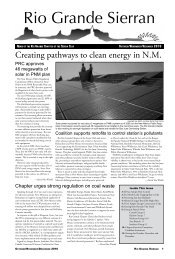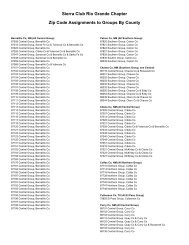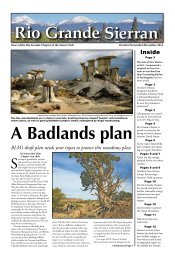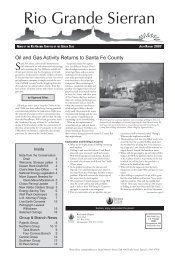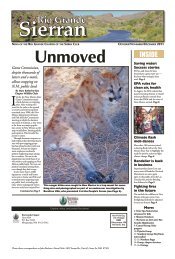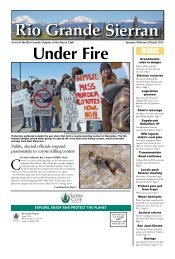Choosing pollution Your photo - Rio Grande Chapter
Choosing pollution Your photo - Rio Grande Chapter
Choosing pollution Your photo - Rio Grande Chapter
You also want an ePaper? Increase the reach of your titles
YUMPU automatically turns print PDFs into web optimized ePapers that Google loves.
Central Group<br />
Photo by Jeff Potter<br />
70 acres lie empty at the former Los Angeles landfill, where the city of Albuquerque spends hundreds of thousands of dollars in<br />
remediation costs each year to capture airborne and water-borne <strong>pollution</strong>.<br />
What the trash left behind<br />
Vacated Albuquerque landfills<br />
leave environmental legacy to<br />
deal with for decades<br />
By Jeff Potter<br />
Central Group<br />
Out of sight but not out of mind A large<br />
city such as Albuquerque vibrantly<br />
breathes, consumes and creates multitudes<br />
of waste daily, yet we citizens<br />
go on unaware of the cumulative effect. According<br />
to the City of Albuquerque Environmental Health<br />
Department, the city pledges to “monitor, characterize<br />
and, if necessary, clean up eight additional former<br />
City-owned and/or operated landfills to protect the<br />
environment and the public’s health and safety.”<br />
One such former landfill is located east of the<br />
Albuquerque Metropolitan Arroyo Flood Control<br />
Authority channel between two heavily used east-west<br />
corridors, Paseo del Norte and Alameda Boulevard.<br />
Given the extensive development of most available<br />
land in the area, the 70-acre section stands empty, and<br />
one might wonder why it hasn’t seen development.<br />
No doubt many who pass by in their hurried commute<br />
don’t realize the reason: What lies beneath is<br />
the former Los Angeles landfill and its environmental<br />
burden from millions of tons of waste decomposing<br />
for decades and inherent other problems.<br />
In 1978, Albuquerque’s northern boundary was<br />
where the city decided to locate its municipal landfill.<br />
The site was chosen along Los Angeles Boulevard,<br />
which in 1990 became Paseo del Norte.<br />
The site was typical for landfills in cities at that<br />
time—namely, an excavated, unlined pit that was<br />
filled with 2.8 million tons of unregulated refuse from<br />
1978 to 1983. Nowadays, Albuquerque and Bernalillo<br />
County haul refuse well west of the city limits at the<br />
Cerro Colorado site. There were similar sites to the<br />
Los Angeles landfill near the present-day Mesa del Sol<br />
planned community, at the south end of Eubank Boulevard<br />
and also just east of Paseo del Volcan and I-40.<br />
Despite rampant sprawl westward, the explosive<br />
growth of Albuquerque since the late 1970s has<br />
Central Group<br />
P.O. Box 25342, Albuquerque, NM 87125-<br />
0342<br />
Executive Committee<br />
Julie Wilt: Acting Chair<br />
julie@thewilts.net, 505-404-0972<br />
Eva Thaddeus: Co-Chair, Secretary, Climate<br />
Change Chair evathad@nmia.com, 505-266-<br />
9646<br />
David Ther: Treasurer, Outings Chair, Nominating<br />
grelbik@gmail.com , 505-260-1553.<br />
Jeff Potter, 505/897-8621, jpotter@unm.edu<br />
Tammy Fiebelkorn, Political Chair<br />
Executive Committee meets on the first Tuesday<br />
of each month at 7 p.m. Call for location.<br />
enveloped what used to be barren fields between I-25<br />
and the rural North Valley bottomland. The area<br />
has seen industrial, residential development, and the<br />
building of the important Anderson-Abruzzo Balloon<br />
Fiesta Park. The environmental risks associated<br />
with landfills include subsidence, methane gas and<br />
water <strong>pollution</strong>, and the Los Angeles landfill has seen<br />
issues with all of these.<br />
The landfill emits a sizeable amount of methane<br />
gas; the city’s Environmental Health Department<br />
has installed a landfill gas-extraction system using 59<br />
wells to capture the flammable methane. The first<br />
of its kind in New Mexico, the extraction system<br />
removes 3.4 tons of landfill gas daily. Gas removal<br />
diminishes the potential for landfill contaminants to<br />
travel as a gas and dissolve into the groundwater. It<br />
also protects the public’s health and safety from the<br />
potential for these gases to concentrate in enclosed<br />
areas where harmful vapors could be inhaled or an<br />
explosive situation could occur. The city has built<br />
a first-in-New Mexico gas-to-energy system that<br />
consists of a 70kW microturbine that captures the<br />
landfill gas and produces electricity. The microturbine<br />
was acquired and installed with the assistance of<br />
a Clean Energy grant from the New Mexico Department<br />
of Energy, Minerals and Natural Resources.<br />
The landfill has also generated a plume of waterborne<br />
<strong>pollution</strong> that is moving south toward the<br />
aquifer. The city has installed collection wells and is<br />
re-injecting reclaimed water into the aquifer near the<br />
PNM Reeves Generating Station along El Pueblo<br />
Road. All told, the city spends several hundred thousand<br />
dollars a year in remediation costs.<br />
Whether there is another, tragic legacy to the Los<br />
Angeles landfill remains unknown. According to<br />
a 2007 story in the former Albuquerque Tribune,<br />
Mary Carnes, 52, an environmental scientist with<br />
the city’s Environmental Health Department, was<br />
taking meter readings at the Los Angeles Landfill<br />
south of Balloon Fiesta Park and, while working in<br />
a pit in the ground, she died. A medical examiner’s<br />
report lists the cause and manner of Carnes’ death<br />
as “undetermined.” The Albuquerque Fire Department<br />
took air samples that didn’t show dangerous<br />
amounts of methane or hydrogen sulfide, gases that<br />
old landfills routinely emit. A separate report written<br />
for the city’s life-insurance company concludes that<br />
Carnes died due to lack of oxygen. The New Mexico<br />
Occupational Health and Safety Bureau leveled four<br />
citations against the city, all centering around a failure<br />
to classify the pit Carnes died in as a hazardous<br />
confined space. The state subsequently ordered the<br />
city to pay $6,500 in fines.<br />
Finally, since the Balloon Fiesta uses the area each<br />
fall as an RV parking area, any potential human hazard<br />
should be well disseminated to parking-area users.<br />
According to Steve Wentworth, an area resident<br />
and member of the Balloon Fiesta Park Commission,<br />
“During the Balloon Fiesta there is 24/7 monitoring<br />
by the Albq. Fire Dept. and contractors for the<br />
Environmental Health Dept. There have been no<br />
problems in all the years the Fiesta has used the area.<br />
Several hundred RVs and motor homes use the area<br />
and many use barbeques without negative issues.”<br />
For more on Carnes: “Scientist’s mysterious death<br />
while working at landfill stirs conflict”: www.abqtrib.<br />
com/news/2007/may/29/scientists-mysterious-deathwhile-working-landfill/<br />
July/August/September 2011 rio <strong>Grande</strong> Sierran 7



